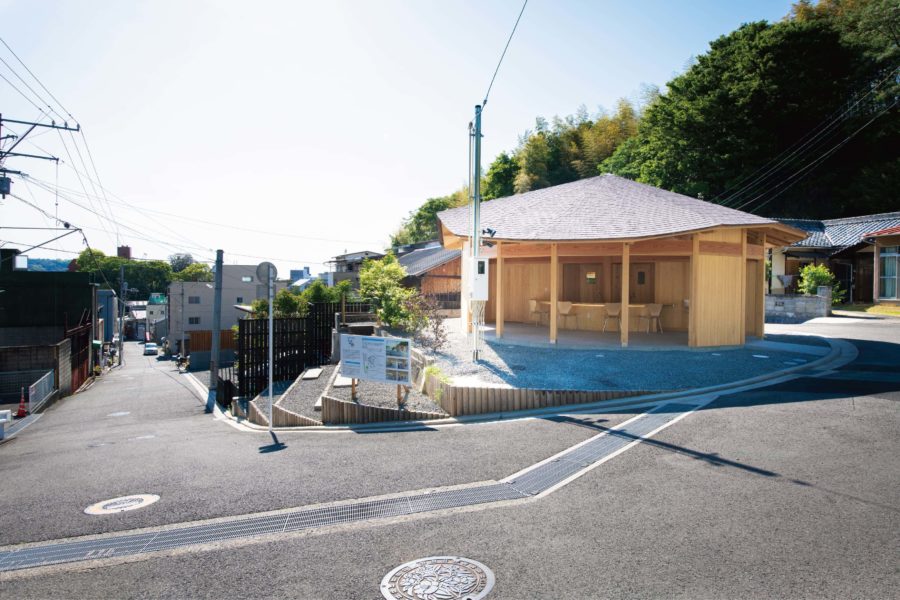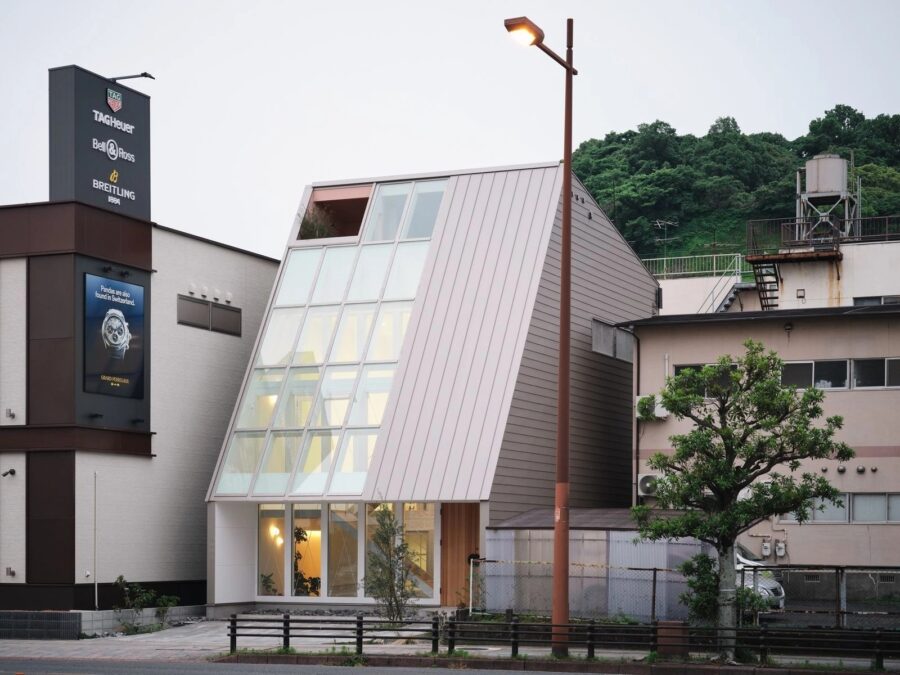建主は元々都内に住んでいたが、仕事の関係で数年前にこのエリアに移住した。この地の空気や食を気に入り、家を建てることを決意した。そして、ここに家を建てるのであれば、専用住居ではなく地域との接点をもてる生業の場を設けることを望んでいた。ただし、設計時点では何の店にするか決めておらず、流動的に中身が入れ替わる場を考えていた。
店舗部分は道に面して設け、住居部分は半屋外の通り土間を挟んで設けている。ただし、通り土間上部で店と住居は繋がっており、店の音や空気は住居に流れ込んでくる構成となっている。この建築では、このような「離れつつ繋がっている」状態を、いくつかの操作によってつくりだしている。
屋根は、軒の出が徐々に深くなる雁行したかたちになっている。これは細長い敷地形状に対して、店から住居におけるプライバシーの必要度に合わせて、軒の出を操作したかたちである。奥の寝室に向かうにつれて軒の出は深くなり、最も出ているところで1600mm程度となっている。隣地の塀と合わさり、プライバシーを保つ閾(しきい)となっている。
長手方向においては、町〜店〜通り土間〜住居が連続している。住居の奥はサンルームだが、プライベートなネイルサロンとしても使用することになった。その先には開けた庭があり、街並みを挟んで瑞龍山という水戸徳川家代々の墓所となっている山がある。町から店や住居を介して史跡までの連続性を、この屋根は導き出している。
隣地とは心理的な距離を取り、町や店や史跡と繋がる。距離を取る対象と繋がる対象を選び取ることが、この住宅には必要だと考えた。本計画はCovid-19が蔓延する前から計画してきたものであるが、奇しくも住宅において重要となる距離の問題に触れた建築となっている。(藤田雄介+伊藤茉莉子)
A house that adjusts the distance to the surroundings by the eaves
It is a wooden one-story store-combined house planned in Hitachiota City, Ibaraki Prefecture.
The owner originally lived in Tokyo but moved to this area a few years ago due to work. He liked the atmosphere and food of the area and decided to build a house. And if you want to build a house here, you wanted to set up a store that has contact with the community instead of a private residence. However, at the time of design, we had not decided what kind of store to make, and we were thinking of a store that would be replaced fluidly.
The store part is set up facing the road, and the residential part is set up across the dirt floor of a semi-outdoor street. However, the store and the residence are connected at the upper part of the dirt floor, and the sound and air of the store flow into the residence. In this architecture, such a “separate and connected” state is created by several operations.
The roof has a goose-like shape, with the eaves gradually deepening. This is a shape in which the eaves are manipulated according to the need for privacy from the store to the residence for the elongated site shape. The eaves are deeper as you approach the bedroom, and the maximum height is about 1600 mm. Together with the adjacent fence, it is a border space that maintains privacy.
In the longitudinal direction, the town, the store, the street, the dirt floor, and the residence are continuous. The back of the house is a solarium, but it will also be used as a private nail salon. Beyond that, there is an open garden, and across the city, there is a mountain called Zuiryuzan, which has become a graveyard for the Mito Tokugawa family. This roof derives a continuity from the town through shops and residences to historic sites.
Keep a psychological distance from the neighboring land and connect to towns, shops, and historic sites. I thought that it was necessary for this house to select the target to keep the distance and the target to connect. The project, which was planned before the Covid-19 epidemic, touches on strangely important distance issues in housing. (Yusuke Fujita + Mariko Ito)
【常陸太田の町家】
所在地:茨城県常陸太田市
用途:店舗併用住宅
クライアント:個人
竣工:2020年
設計:Camp Design
担当:藤田雄介+伊藤茉莉子
構造設計:大川誠治(soso)
施工:小薗建設
撮影:長谷川健太
工事種別:新築
構造:木造
規模:地上1階
敷地面積:492.23m²
建築面積:104.46m²
延床面積:89.43m²
設計期間:2018.08-2019.09
施工期間:2019.10-2020.05
【Machiya in Hitachi-ota】
Location: Hitachiota-shi, Ibaraki, Japan
Principal use: Store combined housing
Client: Individual
Completion: 2020
Architects: Camp Design
Design team: Yusuke Fujita + Mariko Ito
Structure engineer: Seiji Okawa / soso
Contractor: Osono Construction
Photographs: Kenta Hasegawa
Construction type: New Building
Main structure: Wood
Building scale: 1 story
Site area: 492.23m²
Building area: 104.46m²
Total floor area: 89.43m²
Design term: 2018.08-2019.09
Construction term: 2019.10-2020.05








